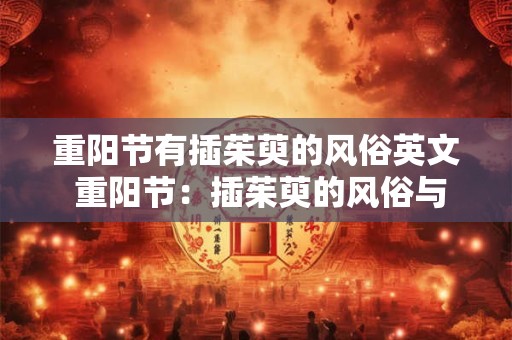The Chongyang Festival: The Custom of Wearing Chrysanthemum Leaves and Its Cultural Significance
As the autumn breeze begins to blow, the Chongyang Festival, also known as the Double Ninth Festival, is upon us. This traditional Chinese festival, celebrated on the ninth day of the ninth lunar month, has a long history and rich cultural connotations. One of the most distinctive customs associated with this festival is the wearing of chrysanthemum leaves, which symbolizes health, longevity, and happiness. This article will delve into the custom of wearing chrysanthemum leaves during the Chongyang Festival and explore its cultural significance.
I. Origin and History of the Chongyang Festival
The Chongyang Festival has a history of over 2,000 years. It originated in the Eastern Han Dynasty and is closely related to the worship of the elderly and ancestors. The festival is also associated with the autumn harvest, as it is believed that the crops are fully ripe on this day. The name "Chongyang" comes from the Chinese characters "重陽" (chóng yáng), which mean "double the ninth."
II. The Custom of Wearing Chrysanthemum Leaves
One of the most iconic customs of the Chongyang Festival is the wearing of chrysanthemum leaves. Chrysanthemum leaves, also known as "菊花" (jú huā) in Chinese, are believed to have medicinal properties that can ward off evil spirits and promote longevity. The custom of wearing chrysanthemum leaves dates back to the Western Han Dynasty.
During the Chongyang Festival, people of all ages wear chrysanthemum leaves or place them on their doorsteps. The leaves are often tied with red ribbons or strings to symbolize happiness and good fortune. In some regions, people also make chrysanthemum leaf necklaces or bracelets for themselves and their loved ones.
III. Cultural Significance of Wearing Chrysanthemum Leaves
The custom of wearing chrysanthemum leaves during the Chongyang Festival has profound cultural significance. Here are some of the key aspects:
A. Longevity and Health
Chrysanthemum leaves are believed to have medicinal properties that can improve health and longevity. The ancient Chinese believed that drinking chrysanthemum tea or eating chrysanthemum leaves could help prevent diseases and extend life. Therefore, wearing chrysanthemum leaves during the Chongyang Festival is a symbol of good health and longevity.
B. Respect for the Elderly
The Chongyang Festival is also a time to show respect for the elderly. Wearing chrysanthemum leaves is a way to express gratitude to the elderly for their guidance and wisdom. It is also a reminder to take care of the elderly and ensure their well-being.
C. Celebration of the Harvest
The Chongyang Festival is closely related to the autumn harvest. Wearing chrysanthemum leaves is a way to celebrate the bountiful harvest and express gratitude to nature for its abundance. It is also a symbol of hope for a prosperous future.
D. Cultural Heritage
The custom of wearing chrysanthemum leaves during the Chongyang Festival is an important part of Chinese cultural heritage. It reflects the ancient Chinese people's wisdom and understanding of nature, as well as their pursuit of happiness and longevity.
IV. Modern Practices of the Chongyang Festival
In modern times, the Chongyang Festival has evolved in various ways. While the custom of wearing chrysanthemum leaves remains, people have also developed new ways to celebrate the festival. Some of the modern practices include:
A. Chrysanthemum Flower Exhibitions
During the Chongyang Festival, many cities and towns hold chrysanthemum flower exhibitions. These exhibitions showcase a variety of chrysanthemum flowers, with unique shapes, colors, and sizes. Visitors can appreciate the beauty of these flowers and learn about their cultural significance.
B. Family Gatherings
The Chongyang Festival is a time for family reunions. People gather with their families to enjoy a feast, exchange gifts, and share stories. This tradition emphasizes the importance of family bonds and the value of togetherness.
C. Health and Fitness Activities
To promote health and longevity, many people participate in various activities during the Chongyang Festival. These activities include hiking, climbing, and other outdoor exercises. It is believed that engaging in physical activities on this day can bring good health and longevity.
V. Conclusion

The Chongyang Festival is a time for celebration, reflection, and gratitude. The custom of wearing chrysanthemum leaves is just one of the many traditions that make this festival unique. By exploring the cultural significance of this custom, we can better appreciate the rich heritage of Chinese culture and the values it represents. As we continue to celebrate the Chongyang Festival, let us cherish and pass on these cultural traditions to future generations.
